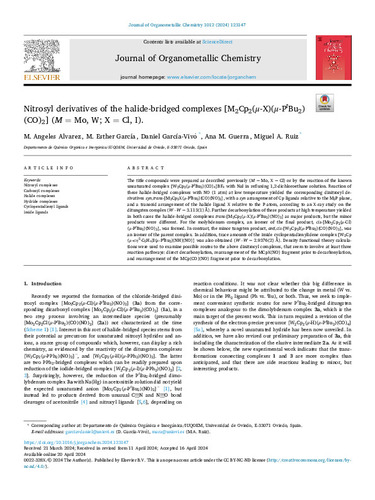Nitrosyl derivatives of the halide-bridged complexes [M2Cp2(μ-X)(μ-PtBu2)(CO)2] (M = Mo, W; X = Cl, I)
Fecha de publicación:
Versión del editor:
Citación:
Resumen:
The title compounds were prepared as described previously (M = Mo, X = Cl) or by the reaction of the known unsaturated complex [W2Cp2(μ-PtBu2)(CO)4]BF4 with NaI in refluxing 1,2-dichloroethane solution. Reaction of these halide-bridged complexes with NO (1 atm) at low temperature yielded the corresponding dinitrosyl de- rivatives syn,trans-[M2Cp2X(μ-PtBu2)(CO)(NO)2], with a syn arrangement of Cp ligands relative to the M2P plane, and a transoid arrangement of the halide ligand X relative to the P atom, according to an X-ray study on the ditungsten complex (W W = 3.113(1) Å). Further decarbonylation of these products at high temperature yielded in both cases the halide-bridged complexes trans-[M2Cp2(μ-X)(μ-PtBu2)(NO)2] as major products, but the minor products were different. For the molybdenum complex, an isomer of the final product, cis-[Mo2Cp2(μ-Cl) (μ-PtBu2)(NO)2], was formed. In contrast, the minor tungsten product, anti,cis-[W2Cp2I(μ-PtBu2)(CO)(NO)2], was an isomer of the parent complex. In addition, trace amounts of the imide cyclopentadienylidene complex [W2Cp (μ-κ:η5-C5H4)I(μ-PtBu2)(NH)(NO)] was also obtained (W W = 2.9376(2) Å). Density functional theory calcula- tions were used to examine possible routes to the above dinitrosyl complexes, that seem to involve at least three reaction pathways: direct decarbonylation, rearrangement of the MCpX(NO) fragment prior to decarbonylation, and rearrangement of the MCp(CO)(NO) fragment prior to decarbonylation.
The title compounds were prepared as described previously (M = Mo, X = Cl) or by the reaction of the known unsaturated complex [W2Cp2(μ-PtBu2)(CO)4]BF4 with NaI in refluxing 1,2-dichloroethane solution. Reaction of these halide-bridged complexes with NO (1 atm) at low temperature yielded the corresponding dinitrosyl de- rivatives syn,trans-[M2Cp2X(μ-PtBu2)(CO)(NO)2], with a syn arrangement of Cp ligands relative to the M2P plane, and a transoid arrangement of the halide ligand X relative to the P atom, according to an X-ray study on the ditungsten complex (W W = 3.113(1) Å). Further decarbonylation of these products at high temperature yielded in both cases the halide-bridged complexes trans-[M2Cp2(μ-X)(μ-PtBu2)(NO)2] as major products, but the minor products were different. For the molybdenum complex, an isomer of the final product, cis-[Mo2Cp2(μ-Cl) (μ-PtBu2)(NO)2], was formed. In contrast, the minor tungsten product, anti,cis-[W2Cp2I(μ-PtBu2)(CO)(NO)2], was an isomer of the parent complex. In addition, trace amounts of the imide cyclopentadienylidene complex [W2Cp (μ-κ:η5-C5H4)I(μ-PtBu2)(NH)(NO)] was also obtained (W W = 2.9376(2) Å). Density functional theory calcula- tions were used to examine possible routes to the above dinitrosyl complexes, that seem to involve at least three reaction pathways: direct decarbonylation, rearrangement of the MCpX(NO) fragment prior to decarbonylation, and rearrangement of the MCp(CO)(NO) fragment prior to decarbonylation.
ISSN:
Patrocinado por:
MICIU; AEI of Spain; FEDER [PGC2021-123964NB-I00]; SCBI of the Universidad de Malaga, Spain
Colecciones
- Artículos [37540]
- Investigaciones y Documentos OpenAIRE [8402]
- Química Orgánica e Inorgánica [518]
Ficheros en el ítem





